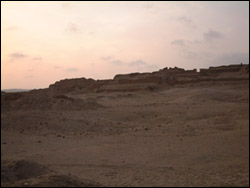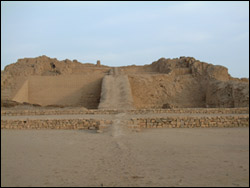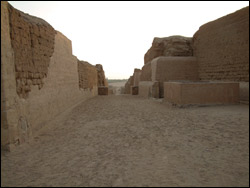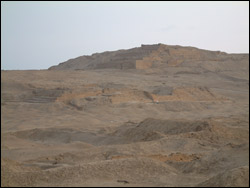The site of Pachacamac
 Pachacamac is situated about half a kilometre from the Pacific Ocean, on the right bank
of the Lurín river, close to its mouth. Permanent occupation at the site
probably began during the Early Intermediate Period (200BC-AD550). At that time
the lower Rímac and Lurín valleys were under the dominion of a
stratified polity whose centre was situated in the Rímac valley. The
Lima culture, as it is known, was characterized by a specific ceramic style
and huge adobe-made platform mounds. Lima buildings at Pachacamac include the
Old Temple of Pachacamac, a small building called the “Conjunto de adobitos”,
other platform mounds and cemeteries. Pachacamac is situated about half a kilometre from the Pacific Ocean, on the right bank
of the Lurín river, close to its mouth. Permanent occupation at the site
probably began during the Early Intermediate Period (200BC-AD550). At that time
the lower Rímac and Lurín valleys were under the dominion of a
stratified polity whose centre was situated in the Rímac valley. The
Lima culture, as it is known, was characterized by a specific ceramic style
and huge adobe-made platform mounds. Lima buildings at Pachacamac include the
Old Temple of Pachacamac, a small building called the “Conjunto de adobitos”,
other platform mounds and cemeteries.
|
| Most authors believe that the site was already an important
religious centre during that period. By the beginning of the Middle Horizon,
Pachacamac had come under Huari influence and became an important centre
for the spread of the iconography and religious ideology of that south-central
highland culture. This was probably due to the prestige of its oracle whose
cult had supposedly long been practised there. During this period, the
Painted Temple was constructed and the Old Temple was abandoned. The cemetery
with elite burials, excavated by Uhle in 1896 at the foot of the Painted
Temple, led to his proposing the first ceramic sequence for the
Central Andes. This sequence has been refined and expanded, but its overall
validity remains unimpaired. Huari's decline at the end of the Middle Horizon,
epoch 2, (around AD800), also signalled a reduction in Pachacamac's sphere
of influence. The following Late Intermediate Period (AD900-1470, hereafter
referred as LIP ) is also the least studied, both at Pachacamac and
on the Central Coast. Written sources suggest that the Ychsma ethnic group
dominated the Lurín Valley at the end of the LIP, but archaeological
definition of this polity is still a matter of debate. Topa Inka Yupanqui's
conquest of the region around AD1470 marked the beginning of the Late Horizon
and Pachacamac (until then called Ychsma) was incorporated into the Inka
empire. The Inka made profound changes at the site, which included the
construction of the Temple of the Sun and an Accllahuasi (House of the
Chosen Women). The oracle became one of the most feared and revered in
the Andes and also the focus of large-scale pilgrimages, which were encouraged
by the Inkas. When the Spaniards arrived there in January 1533, it was
one of Peru's largest and most impressive settlements. However, within
a few years of the conquest it was completely abandoned. |
The site covers a surface area of about 600 hectares,
of which one third is occupied by buildings in the monumental sector.
The latter is divided into two main parts by two concentric enclosures.
The first enclosure, known as The Sacred Precinct, includes such buildings
as the Old Temple of Pachacamac, the Painted Temple, the Temple of the
Sun, an important cemetery and the foundations of a rectangular structure
that is now totally destroyed. The second enclosure includes streets,
cemeteries, numerous patios, open spaces and most pyramids with ramps
(see below), except for Pyramids V and VII, which are situated in the
desert zone separating the second enclosure wall from a third one, which
marks the exterior of the site. A fourth enclosure wall is located about
one kilometre north from the third.
|

![]() Pachacamac is situated about half a kilometre from the Pacific Ocean, on the right bank
of the Lurín river, close to its mouth. Permanent occupation at the site
probably began during the Early Intermediate Period (200BC-AD550). At that time
the lower Rímac and Lurín valleys were under the dominion of a
stratified polity whose centre was situated in the Rímac valley. The
Lima culture, as it is known, was characterized by a specific ceramic style
and huge adobe-made platform mounds. Lima buildings at Pachacamac include the
Old Temple of Pachacamac, a small building called the “Conjunto de adobitos”,
other platform mounds and cemeteries.
Pachacamac is situated about half a kilometre from the Pacific Ocean, on the right bank
of the Lurín river, close to its mouth. Permanent occupation at the site
probably began during the Early Intermediate Period (200BC-AD550). At that time
the lower Rímac and Lurín valleys were under the dominion of a
stratified polity whose centre was situated in the Rímac valley. The
Lima culture, as it is known, was characterized by a specific ceramic style
and huge adobe-made platform mounds. Lima buildings at Pachacamac include the
Old Temple of Pachacamac, a small building called the “Conjunto de adobitos”,
other platform mounds and cemeteries. 



![]()